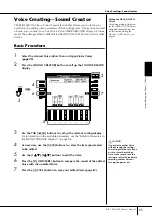
Using, Creating and Editing
V
oices
Changing Pitch
PSR-3000/1500 Owner’s Manual
82
4
Change the following settings as necessary.
• Tuning the individual notes of the keyboard (TUNE)
1
Press the [3
π
π
π
π†
†
†
†
] button to select the note for tuning.
2
Use the [4
π
π
π
π†
†
†
†
]/[5
π
π
π
π†
†
†
†
] buttons to set the tuning in cents.
• Determines the base note for each scale.
Press the [2
π†
] button to select the base note.
When the base note is changed, the pitch of the keyboard is transposed,
yet maintains the original pitch relationship between the notes.
Preset Scale Types
Tuning values for Preset Scales (base note: C) (in cents)
* In the display, the rounded off value is shown.
Cent:
In musical terms a “cent” is 1/
100th of a semitone. (100 cents
equal one semitone.)
Instantly recalling the desired
scale
Register the desired scale to the
Registration Memory. Be sure to
checkmark the SCALE item when
registering (page 129).
EQUAL
TEMPERAMENT
The pitch range of each octave is divided equally into twelve parts, with
each half-step evenly spaced in pitch. This is the most commonly used
tuning in music today.
PURE MAJOR
PURE MINOR
These tunings preserve the pure mathematical intervals of each scale,
especially for triad chords (root, third, fifth). You can hear this best in
actual vocal harmonies – such as choirs and a cappella singing.
PYTHAGOREAN
This scale was devised by the famous Greek philosopher and is created
from a series of perfect fifths, which are collapsed into a single octave.
The 3rd in this tuning are slightly unstable, but the 4th and 5th are
beautiful and suitable for some leads.
MEAN-TONE
This scale was created as an improvement on the Pythagorean scale, by
making the major third interval more “in tune.” It was especially popu-
lar from the 16th century to the 18th century. Handel, among others,
used this scale.
WERCKMEISTER
KIRNBERGER
This composite scale combines the Werckmeister and Kirnberger sys-
tems, which were themselves improvements on the mean-tone and
Pythagorean scales. The main feature of this scale is that each key has
its own unique character. The scale was used extensively during the
time of Bach and Beethoven, and even now it is often used when per-
forming period music on the harpsichord.
ARABIC
Use these tunings when playing Arabic music.
C
C
#
D
E
b
E
F
F
#
G
A
b
A
B
b
B
EQUAL TEM-
PERAMENT
0
0
0
0
0
0
0
0
0
0
0
0
PURE MAJOR
0
-29.7
3.9
15.6
-14.1
-2.3
-9.4
2.3
-27.3 -15.6
18.0
-11.7
PURE MINOR
0
33.6
3.9
15.6
-14.1
-2.3
31.3
2.3
14.1
-15.6
18.0
-11.7
PYTHAGOREAN
0
14.1
3.9
-6.3
7.8
-2.3
11.7
2.3
15.6
6.3
-3.9
10.2
MEAN-TONE
0
-24.2
-7.0
10.2
-14.1
3.1
-20.3
-3.1
-27.3 -10.2
7.0
-17.2
WERCKMEISTER
0
-10.2
-7.8
-6.3
-10.2
-2.3
-11.7
-3.9
-7.8
-11.7
-3.9
-7.8
KIRNBERGER
0
-10.2
-7.0
-6.3
-14.1
-2.3
-10.2
-3.1
-7.8
-10.2
-3.9
-11.7
ARABIC 1
0
0
-50.0
0
0
0
0
0
0
-50.0
0
0
ARABIC 2
0
0
0
0
-50.0
0
0
0
0
0
0
-50.0
















































